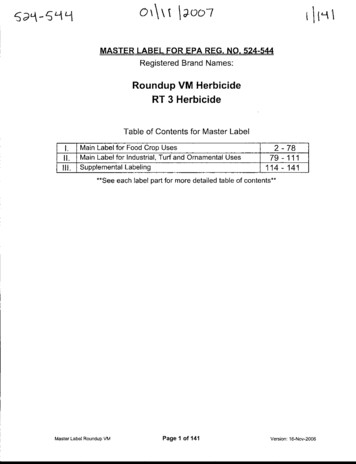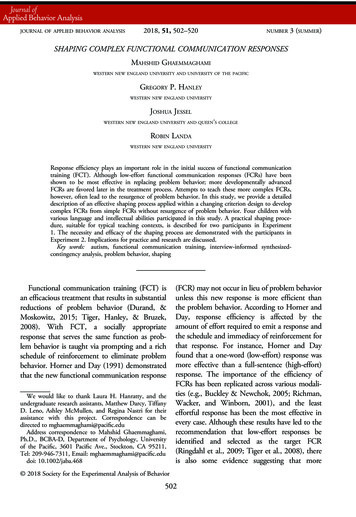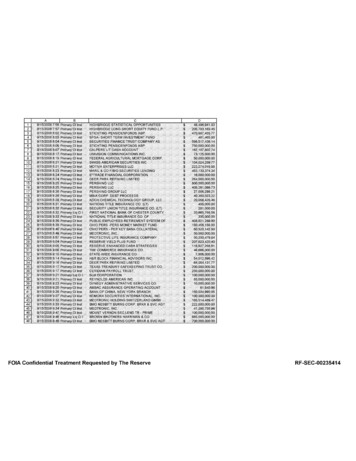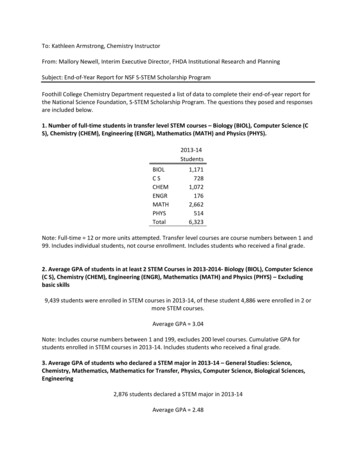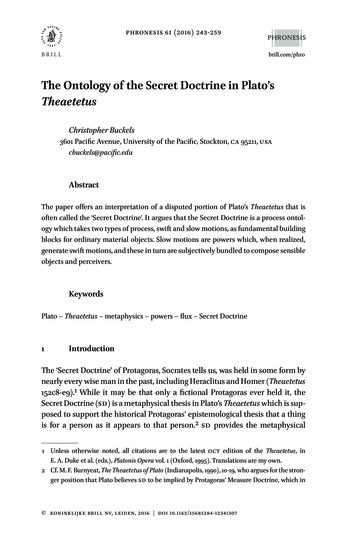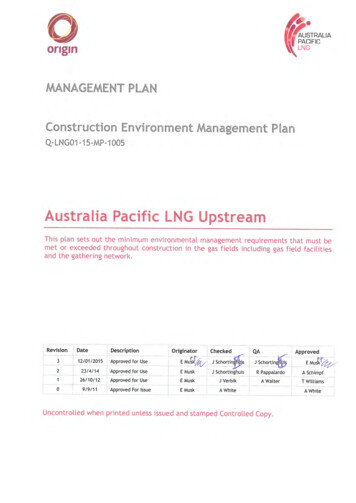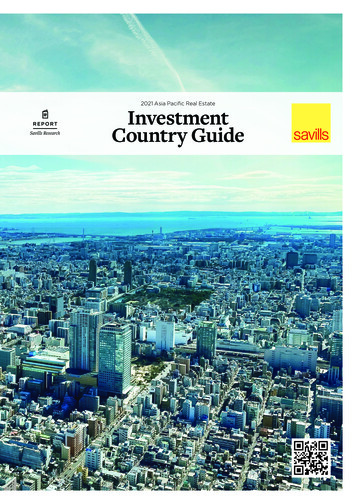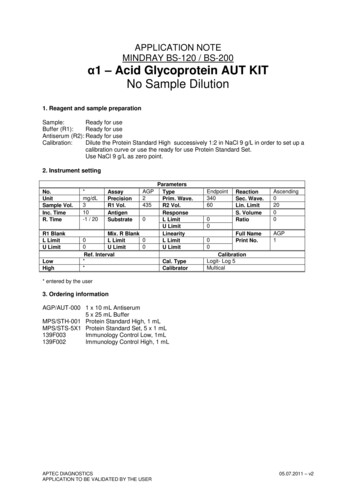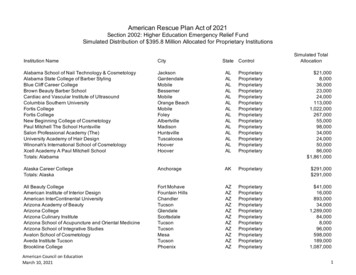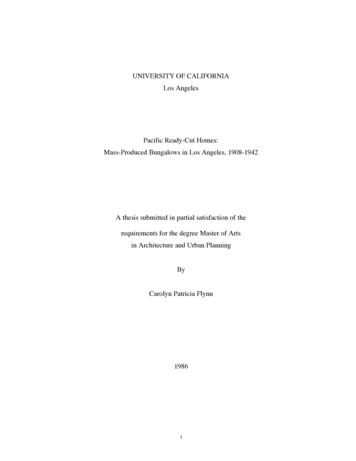
Transcription
UNIVERSITY OF CALIFORNIALos AngelesPacific Ready-Cut Homes:Mass-Produced Bungalows in Los Angeles, 1908-1942A thesis submitted in partial satisfaction of therequirements for the degree Master of Artsin Architecture and Urban PlanningByCarolyn Patricia Flynn1986i
iiCopyright byCarolyn Patricia Flynn1986ii
iiiThe thesis of Carolyn Patricia Flynn is approved.University of California, Los Angeles1986iii
ivForJoyce Mangouneyiv
vTABLE OF CONTENTSCHAPTER 1INTRODUCTION:"A Complete HomeEvery Twenty Minutes. . . . . . . . . . . . . . . . . . . . . . . . . . . . . . . . . . 1CHAPTER 2THE PORTABLE BUNGALOW, 1908-1915 . . . . . . . . . . . . . . 11The Building TradesWorking-Class HomeownershipThe New Suburban HomeHome EconomicsCHAPTER 3THE READY-CUT HOME, 1916-1925 . . . . . . . . . . . . . . . . . . . 42The Auto and the HomeTechnology and Housing ReformNailing the Pieces Into PlaceModel Homes and HousewivesCHAPTER 4THE SOCIAL AND TECHNOLOGICAL LEGACY . . . . . . . . 80The Problem with Mass-Produced HousesThe Mass-Produced House ReturnsFootnotes . . . . . . . . . . . . . . . . . . . . . . . . . . . . . . . . . . . . . . . . . . . . . . . . . . . . . . . . . . 96Bibliography . . . . . . . . . . . . . . . . . . . . . . . . . . . . . . . . . . . . . . . . . . . . . . . . . . . . . . 121Illustrations . . . . . . . . . . . . . . . . . . . . . . . . . . . . . . . . . . . . . . . . . . . . . . . . . . . . . . . 127v
viACKNOWLEDGEMENTSRobert Butte shared generously with me his knowledge of his father's company, his ownprivate photograph collection, and granted me permission to reproduce from his father'spublished catalogs. His assistance is greatly appreciated.I would like to acknowledge important financial support from the Barry A. Berkussystems Building and Housing Research Fellowship, which I was awarded through theGraduate School of Architecture and Urban Planning in 1984/85.I would also like to acknowledge the personal support and intellectual stimulation ofGail Dubrow and Sherry Katz, the scholars who taught me to be an historian.vi
viiABSTRACT OF THE THESISPacific Ready-Cut Homes:Mass-Produced Bungalows in Los Angeles, 1908-1942ByCarolyn Patricia FlynnMaster of Arts in Architecture and Urban PlanningUniversity of California, Los Angeles, 1986Professor Dolores Hayden, ChairThe 1920's was a unique decade in which the industrial production of housingintersected with the rising demand for single-family homeownership to producehundreds of thousands of mass-produced single-family homes on the Americanlandscape. Pacific Ready-Cut Homes was a major producer of these houses. WilliamButte, Pacific's aggressive co-founder and President, built a 24-acre plant capable ofproducing a complete home every twenty minutes. The factory was one of a handful inthe country where workers mass-produced precut lumber and manufacturedcomponents for "ready-cut" houses.This study of Pacific Ready-Cut Homes explores the many social and politicalimplications of the ready-cut production process and its mass-produced product, thesingle-family home. First, the ready-cut building system de-skilled the labor ofcarpenters into the relatively simple process of nailing together pre-preparedmaterials, and put more building workers in factories. Second, it produced,quickly and cheaply, a pattern of single-family homeownership which becamepart of a political movement to pacify labor and to confine women to the home.vii
viiiWhile many progressive Americans had criticized the single-family home as outdated,wasteful of women's labor and too expensive to house the working class, industrialistsand businessmen staunchly supported single-family homeownership as the backbone ofthe American capitalist system.They supported a technological strategy to decrease the cost of the single-family homeso that working-class families could afford it.The ready-cut system was the most successful part of this technological strategy, and inthe Western United States, William Butte of Pacific Ready-Cut Homes sold 40,000mass-produced ready-cut bungalows, becoming the third largest industrial producer ofhousing in the country.viii
1CHAPTER 1INTRODUCTION"A Complete Home Every Twenty Minutes"The 1920's was a unique decade when the industrial production of housing intersectedwith the rising demand for single-family homeownership to produce hundreds ofthousands of mass-produced single-family homes on the American landscape. PacificReady-cut Homes was a major producer of these houses, lining the low-densityneighborhoods of Los Angeles with thousands of small bungalows. William Butte,Pacific's aggressive cofounder and President, built a 24-acre plant which produced40,000 houses. The plant was one of a handful in the country where workers massproduced pre-cut lumber and manufactured components for "ready-cut" dwellings. Thisstudy is an exploration of the many social and political implications of the ready-cutproduction process and its mass-produced product, the single-family home.Though the application of industrial factory techniques to the production of houses metwith great success during the 1920's, the phenomenon has not been widely studied. It hasnot been addressed in the context of the political debates regarding housing or in thecontext of the broadening of the mass-production economy during the period. Only afew scholars have written, briefly, about Pacific Ready-cut Homes. In A History ofPrefabrication, originally a series of articles for Architectural Forum published in 1942,Alfred Bruce and Harold Sandbank described the Pacific building system, including aphotograph of the factory and of a typical Pacific bungalow.They recognize the ready-cut system as the most successful application of factory massproduction methods to housing, surpassing remarkable innovations with cement andsteel structures. But Bruce and Sandbank are an exception; many scholars ofprefabricated housing focus on architects' marginally successful experiments withdesigning prefabricated dwellings.1
2In The Dream of the Factory-Made House, for example, Gilbert Herbert focuses on thework of Walter Gropius and Konrad Wachsmann, two major German architects who ledin the development of prefabrication design and theory beginning in the 1920's.Herbert's history of their dream of applying industrial techniques to the production ofhousing overlooks the success of non-architects during the same period. Although hebriefly mentions Sears' Roebuck -- the major builder of ready-cut houses in the 1920's -he puts it in the context of the demand for "less substantial" houses after World War I.This not only misses the significance of the ready-cut system as a major provider of300,000 suburban homes for American families, but also fails to take note of asuccessful period of mass produced housing in a study which has this as itssubject.1Robert winter briefly discusses Pacific Ready-Cut Homes in a completely differentcontext in his architectural history, The California Bungalow. Winter treats thewidespread popularity of the bungalow in the context of the Arts and Crafts movement,but he focuses on architects who designed rustic Craftsman dwellings in harmony withthe natural environment. Clay Lancaster, the best-known architectural historian of theAmerican bungalow, traces its architectural roots to Japan and India. Most of thearchitectural literature on the bungalow focuses on well-known architects and their mostcreative designs, such as the Gamble House by Greene and Greene. Yet many morethousands of bungalows were produced from standardized designs for average workingclass families, and Winter's mention makes a welcome addition to his study and animportant nod to social history.2In this study, I make use of a rich set of studies on housing and suburbanization from the1880's to World War I which provide a broad social and economic analysis of the periodin which William Butte first formed his factory construction company.Gwendolyn Wright in Moralism and the Model Home: Domestic Architecture andCultural Conflict in Chicago, 1873-1913 emphasizes the social and economic relationswhich influenced models for the suburban single-family home, exploring the transition2
3from a highly-ornate, individualized Victorian dwelling to a simple, restrained,scientifically arranged dwelling. This transition made it possible for Pacific Ready-cutHomes to mass-produce small, simple houses and market them as middle-class statusdwellings. Dolores Hayden presents the feminist critique of the single-family home inthe same period in Grand Domestic Revolution: A History of Feminist Designs forAmerican Homes, Neighborhoods, and Cities. Hayden emphasizes that feminists in themid-19th century were aware that increasing privatization of the home and family wasnot in their interest. They responded to the isolation of the rural housewife by proposingthat new patterns of home life be established for urban and suburban families. Haydenexplores the many feminist designs for alternative forms of housing and collectiveapproaches to housework which resulted from this critique. Much of the debate overwomen's labor in the home subsequently shaped the design and marketing of Pacific'shouses, and the critique of the isolated single-family home was repeated during the1930's as one of the problems with the ready-cut system of mass production.3In his seminal study of Boston's suburbanization, Streetcar Suburbs, Sam Bass Warnerviews Boston's suburbanization prior to World War I as a process of thousands ofisolated, separate decisions. Matthew Edel, Elliott Sclar and Daniel Luria offer acontrasting view in Shaky Palaces: Homeownership and Social Mobility in Boston'sSuburbanization, focusing instead on the decisions of a few major developers. Theirstudy is the best analysis of working-class homeownership. They recognize that althoughbusiness hoped that homeownership would make workers less politically assertive, theAmerican working-class, fought for and obtained suburban homes. Although theycritically analyze the impacts of homeownership on the working class, both negativeand positive, they reject the "social control" viewpoint that homeownership was foistedupon the working-class in the first place.4Housing and suburbanization during the 1920's has not received the same in-depthattention by architectural and urban historians as the period prior to World War I.Several scholars, though, have discussed the 1920's in the context of larger studies.Gwendolyn Wright provides the broadest discussion of the period in Building the3
4Dream: A Social History of American Housing. She emphasizes the importance ofHerbert Hoover, Better Homes in America, "Own Your Own Home" campaigns, and thetrend toward suburban conformity. I will make two complementary notes to her analysis.First, she argues that most new dwelling units were set in large planned residentialcommunities, but this probably leaves out a large number of working-class suburbswhich were quickly subdivided into unimaginative grids. In Los Angeles, working-classsuburbs sprang up next to the booming industrial areas to the south and east. WhileWestwood, Beverly Hills and Culver City were planned communities, industrial suburbslike Maywood, Southgate and Huntington Park were not. Pacific Ready-Cut Homesbuilt houses in all of these communities, but it is in the working-class suburbs that onefinds blocks and blocks of ready-cut bungalows. Second, Wright, like Winter, places theimportance of the ready-cut houses in the Craftsman movement of the previous era,arguing that mass production offered the allure of personal craftsmanship for the owner.I will try to show that the ready-cut system had a much larger significance for housingthan providing Arts and Crafts enthusiasts with their own kits to build houses, and thatthe 300,000 ready-cut houses built during the 1920's are best seen as a response to postWorld War I housing needs and as the solutions to housing problems during the 1920's.5Christine Boyer's analysis of the urban planning discourse in America, Dreaming theRational City, provides an important political context for scholars concerned withhousing during the 1920's. She discusses the reliance upon engineering andtechnological solutions to the housing crisis, and explores the development of zoning asa tool to regulate suburbanization and building. Yet few architects and urban planners inthe 1920's discussed the ready-cut system in any detail (it was happening in privateindustry all by itself), and therefore Boyer, whose book uses urban planning literatureas the object of study, does not discuss the major solution to the technological problemshe aptly describes.6Dolores Hayden provides the best political analysis of housing in the 1920's push forhome ownership, traditional gender roles and pacified labor relations in the context ofthe post-World War I Red Scare, when socialists, feminists and even modern homeeconomists were red-baited. She suggests that the policy of working-class4
5homeownership was in many ways a reaction to social unrest; in 1919 women's suffragewas passed and four million workers were on strike. Her research on the feminist designsfor alternative forms of housing suggests that the 1920's was a pivotal decade forAmerican housing, a time when things might have gone another way. In Redesigning theAmerican Dream, Hayden points out that the post-World War II suburban boom was acontinuation of conservative homeownership policies begun by Herbert Hoover duringthe 1920's.7Finally, Stuart Ewen provides an important context for the mass-production of housingin Captains of Consciousness: Advertising and the Social Roots of the ConsumerCulture. Ewen argues that business, in order to sustain demand for mass-production,began to plan for consumption just as carefully as for production, and that advertisingtook on a pervasive role as the conduit for the ideology of consumerism. His studytouches both the production and the consumption of mass-produced housing. He pointsout that the single-family home provided the best urban basis for the consumption ofmass-produced commodities. Yet his analysis of how mass-production industries muststruggle to maintain demand applies to the mass-production of housing as well. Hisexplication of the advertising strategies used to create needs and to stimulatedissatisfaction, particularly "planned obsolescence," the strategy of constantlyintroducing new models, provides an important context for understanding the role whichmodel homes played for Pacific.8This study is divided into three parts. Chapter 2 covers Pacific's early period, from 1908to 1915, when it produced factory-built, portable bungalows. The chapter explores thesocial and economic issues which were influenced by the attempt to produce houses infactories. Chapter 3 explores Pacific's boom period after World War I, when it operatedfrom the 24-acre plant and mass-produced pre-cut lumber for the ready-cut buildingsystem. The chapter discusses the national context for housing after the war, the housingshortage, and chosen priorities for housing during the period.Finally, Chapter 4 describes the legacy of housing in the 1920's and the ready-cut systemafter World War II, when a new generation of builders used industrial productionmethods not only to mass-produce houses, but whole suburbs.5
6I will argue that there were widespread social implications in the mass-production ofhouses both from the standpoint of production and of consumption. The issues ofconsumption are easier to trace because they appear as part of the debate overhomeownership for the working-class and the critique of the single-family home. Thisside of the story deals with the product itself; exploring the process by which the singlefamily home became the mass-produced form reveals a great deal about thefundamentally political process of defining the way in which Americans would live.These issues intersect with the implications of a changed process of building houses. Inexploring the ready-cut system from the production standpoint, one can betterunderstand the economic process whereby industrialization changes skilled handcraftslabor into machine oriented, specialized processes. The ready-cut building system putmore building workers in factories and contributed to the de-skilling of carpentry. Andof course, at the center of the distinction between production and consumption is theAmerican working class, which provided the labor to build "ready-cut" houses, as wellas bought the less-expensive, mass produced product. In working-class neighborhoodsthroughout Los Angeles, one can find the built form which was the product of theseessentially social processes: The mass-produced, ready-cut bungalow.6
7CHAPTER TWOTHE PORTABLE BUNGALOW, 1908-1915In 1909 when William Butte and Francis Barker formed Pacific Portable ConstructionCompany to produce factory-built bungalows, they entered a field which had been thesubject of public debate for several decades. Since 1850, building trades unionists,socialists, housing reformers and feminists had debated the complex social issuesinvolved in American housing. Trade unionists and feminists were concerned with theway industrial capitalism had dramatically altered the labor necessary to both build andmaintain the home. Socialists and housing reformers were concerned about the best wayto house the working-class, debating the pros and cons of working-class homeownership.Much of the debate centered on competing architectural and technological models forAmerican housing, from the modernized single-family dwelling, to multi-familyhousing, to suburban neighborhoods with facilities for housekeeping, child-care andcommunity dining.1Butte and Barker's choices about what to produce, how, and for whom, were inevitablyshaped by this debate. This impact was by no means unreciprocated; their choices, alongwith those of a few other major builders, would eventually significantly alter the debateitself. First, by producing houses in factories, they began the final stage of what had beenthe progressive de-skilling of the building trades during the nineteenth century. Second,by making sturdy single-family houses at low-cost, they made possible more widespreadhomeownership for the working-class. Third, by manufacturing small, simple housesthey incorporated into the built environment a powerful alternative to the large-ornateVictorian style home. And fourth, by designing their homes to be labor-saving forhousework, they demonstrated the possibilities for the commercial use of homeeconomics while maintaining a traditional view of women's roles.Some commentators hailed Pacific Portable Construction Company as the answer to thecountry's housing ills. Certainly William Butte thought so. It does not appear, though,7
8that he arrived in Los Angeles with the idea. Moving in 1907 from Stuebenville, Ohiowith eight years management experience at a roofing company, he began work in LosAngeles as Supervisor at a large roofing organization. Here he noticed a small nearbyfactory which manufactured portable bungalows, and began to spend his lunch breaksstudying the operation. He was quickly converted; within two years of his arrival in L.A.he had formed a partnership with the owner of the factory, Francis Barker.William Butte was just 28, a short, bald man accustomed to supervising andmanagement. As a teenager he had learned the upholstering trade, but at 18 his taste (andsubsequent genius) for management led him to business college. The following year hebecame assistant superintendent of a paper mill, working there steadily for eight yearsuntil he came to Los Angeles for health reasons. A first generation German-Americanraised on strict “Old Country” values, he was a serious, stern man, known to his familyand employees as someone who “meant business.” It was Butte whose visions andunwavering belief in factory construction shaped the small portable bungaloworganization into a major mass provider of housing in the Western United states.2(Illustration 2.1)But it was Francis Barker who first had the idea. Barker was by 1908 an experiencedentrepreneur, having worked in the lumber manufacturing industry in New Englandsince approximately 1880. In 1898 Barker had organized and become President of theSpringfield construction Company, where it is likely he first experimented with factoryconstruction. Barker was politically active as a resident of Springfield, Massachusetts; in1896 he was elected to the city council and the following year was made its president.He moved to Los Angeles in early 1908 and purchased a factory and the equipment tomanufacture portable houses. He was 54. Upon incorporation of Pacific PortableConstruction Company, Barker became President, Butte Secretary/Treasurer.They began with six employees and could manufacture one full house each week. Theirgoal was to construct as much of the house in the factory as was possible and still beable to ship by railroad. Therefore the floor, roof, ceilings and walls were nailed togetherand entirely finished in the factory, with the wood stained or painted and the hardwareinstalled. Doors and windows were hung in position at the mill and then crated for8
9shipment. All built-in furniture was shipped in “completely assembled form, sandpapered and stained, ready to be set into proper place and nailed solid.” As such, thesehomes could be shipped anywhere - to neighboring Santa Monica or out of the countryto Mexico. (Illustration 2.2)Once arrived on-site, the houses were “assembled” -- not constructed -- remarkablyquickly. Their advertising claimed that a small bungalow would take just two days.After four hours “the floor should be down and some of the side sections fitted in place.”At the end of the first day, all sections of the house would be nailed together, includingthe roof. (Illustration 2.3)"Finishing touches” were added the second day.5 Althougheach section arrived plainly marked to correspond to simple plans, the purchaser wasentitled to the free labor of a foreman to "superintend and assist in the erection,"provided the purchaser paid his "carfare, room and board."6 Otherwise the buyers hiredtheir own carpenters, or erected the house themselves.Pacific's factory-built houses and other structures were erected several hundred milesfrom L.A. -- allover California, in Arizona, New Mexico, Nevada and Utah, as well as inLatin America. The product was, in fact, most essentially portable. First, it could beshipped to any locality nominally connected to a railroad. Second, it could bedisassembled, moved, and erected again. These were important characteristics in adeveloping region like the southwestern United States. They made it possible to erecthouses in boom towns so new there were few skilled trades people, and providedtemporary housing for the workers who were building the infrastructure of the region,such as in the railroad and oil companies. For example, the Los Angeles Department ofWater and Power bought Pacific factory built structures to house the workers buildingthe city's famous aqueduct beginning in 1913.7Pacific Portable Construction Company was moderately successful prior to World WarI; in the first six years it sold 5000 factory-built houses. A 1915 history of Los Angelesincluded a biographical entry on Francis Barker, noting that he was President of “Pacificportable Construction Company which manufactures factory built houses of alldescriptions.” (Illustration 2.4)9
10Pacific, it continued, employed "fifty to seventy-five experienced workmen,” and hadbuilt “a fully equipped plant and special varieties of machinery particularly adapted tothis line of work.” They had opened a sales branch, as well, near the Mexican border inEl Centro, where eight salespeople took orders for portable bungalows.8Barker and Butte sold quite an array of factory built structures -- bunkhouses, mess halls,apartment buildings, schools, gasoline stations, garages -- proving that their factoryconstruction system could work on any relatively modest frame structure as well assmall detached houses. (Illustrations 2.5 and 2.6)Their bunkhouses, for example, were undoubtedly used as housing for the thousands ofmigrant farm workers in the region. But by far the most popular item sold was the smallportable bungalow.DE-SKILLING THE CARPENTER: THE BUILDING TRADESNot everybody thought that the increasing factory manufacture of housing was a goodidea. Certainly building trades people, particularly carpenters, had realistic fears aboutthe progressive introduction of machine technology into homebuilding. Almostexclusively native-born or Western European white males, carpenters had for centuriespassed on their relative privilege to family and friends. They had enjoyed a good deal ofcontrol over their trade, earned heal thy incomes, and often owned their own businesses.Labor historian Paul Bullock maintains that the earliest craft guilds were often used “asan exclusionary measure, to maintain monopoly over their craft and to keep‘undesirables’ out."9By the 1850’s carpenters were experiencing an increasing lack of control over their tradedue to larger concentrations of capital being invested in the built environment in majorU.S. cities. As they organized to mitigate these developments, their traditional strengthas elite craftsmen enabled them to form powerful and effective labor unions. Yet theirtrade was becoming increasingly mechanized, a process which was sped up considerablyduring the 1880’s by the introduction of steam-powered machinery. "Productivityimproved dramatically," writes architectural historian Gwendolyn Wright. "Higher-gradesteel blades allowed the steam-powered machines to be used at full speed, without cease,10
11with no danger of metal fatigue.” She cites a case reported in 1898 by the commissionerof labor that mechanical saws could produce in four hours as many irregular forms inwood as would have required 110 hours by hand.10 In the average case, woodworkingmachinering was 12 to 14 times faster than the hand worker.11By 1881 these developments stimulated the carpenters’ locals to organize the unitedBrotherhood of Carpenters and Joiners of America, with Peter McGuire as itscharismatic leader. A carpenter, tireless labor organizer, committed Socialist andtalented editor of the prominent journal, The Carpenter, McGuire was by all accounts"one of the most remarkable figures in the labor movement.”12 His reasons for forming anational union spoke directly to the increasing use of machinery:By the introduction of woodworking machinery operated in planning mills the oldworkshops and their handwork gave way very largely to machine-made moldings,window frames, etc., so that consequently a larger amount of work could be done withless labor in a given time, resulting in protracted periods of idleness and unsteadywork. And in addition, in many cities, the time-honored custom of day-work hasrapidly given way to piece-work, with the minutest subdivision of the trade into pettybranches, lessening the demand for skilled mechanics, and making the introduction ofunskilled labor not only a possibility, but more and more generally the rule.13By 1900, the united Brotherhood of Carpenters and Joiners had led the labor movementin two decades of intense labor unrest, organizing major strikes in several cities whereunionization was strong. This labor activity, coupled with the actual de-skilling ofcarpenters, led to a change in the popular view of the building worker. "Onceromanticized as a traditional craftsman preserving noble skills," writes GwendolynWright, lithe building laborer came to be seen as a petty tyrant holding up progress. apawn of corrupt unions, ready to cut off a city's supply of housing for ever higherwages.” 14This form of animosity towards unionized building workers was particularly strong insome quarters of Los Angeles, backed by a few particularly powerful institutions withinthe city. Some of this was undoubtedly due to the timing of the city's development. LosAngeles experienced its first major surge of growth in the 1880's; its powerful businessinstitutions became consolidated during a time when building workers' strikes elsewherecould paralyze a city. Los Angeles gained a reputation as a staunch "open shop" town,11
12with the Los Angeles Times, the largest and most influential paper in the region, at theforefront. A bitter printers' strike against the Times lasted from 1890 to 1910 withoutsuccess. The Merchants' and Manufacturers’ Association also led in the open-shopcampaign. The M&M "pressured employers to remain non-union, gave them assistanceduring strikes. and, in 1910, secured passage of the toughest municipal anti-picketingordinance in the country.”15But there were many quarters in Los Angeles where the opposite sentiments were helddearly. These forces combined in 1911 when the Socialist Party's slate of candidatestopped most of the city’s primaries, and socialist Job Harriman won a plurality of votesfor mayor. The Socialists did not win the final election, a political occurrence attributedin part to the untimely confession of union workers to the dynamiting of the L.A. Timesbuilding in October 1910. The ultimate failure of the city-wide movement for the unionshop also served to stop the momentum in unionization of the Los Angeles buildingtrades.16This was, of course, the labor environment in which the Pacific Portable constructiongrew and prospered. Butte and Barker ran an open shop, and agreed with theM&M's union policy.17 The Pacific method had its own implications for the buildingtrades. It moved the site of production from the site almost wholly to the factory,where workers manufactured interchangeable components for portable bungalows.The outcome of this rationalization of the labor process was predictable; it hasoccurred countless times in industrial
University of California, Los Angeles, 1986 Professor Dolores Hayden, Chair The 1920's was a unique decade in which the industrial production of housing intersected with the rising demand for single-family homeownership to produce hundreds of thousands of mas
